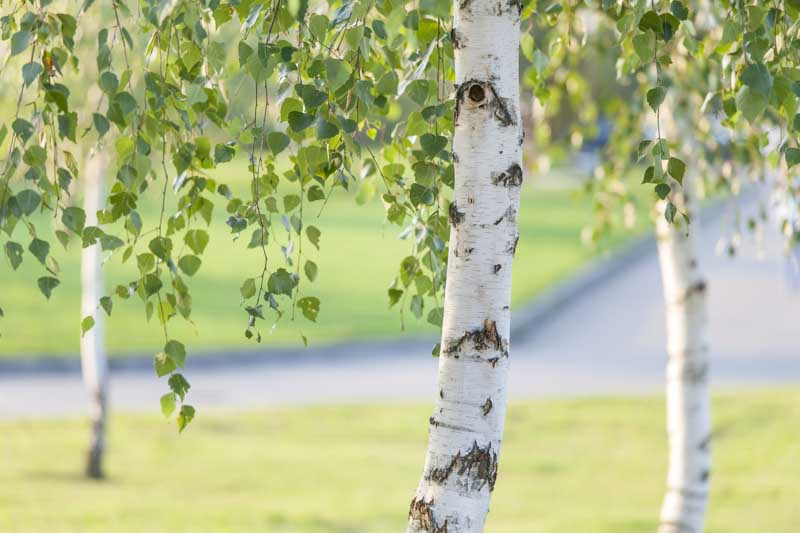Birch trees are susceptible to a range of pests and diseases that can impact their health and appearance. From the invasive bronze birch borer to various types of fungal infections, these issues require vigilant monitoring and timely intervention to maintain the tree's vitality.
Birch trees, part of the Betula genus, are admired for their distinctive, often peeling, bark and slender, graceful forms. Native to various parts of the world, including North America, Europe, and Asia, they adapt well to different climates but thrive best in cooler conditions. Birch trees range widely in size, from small shrubs to towering 80-foot trees, and grow in various habits, including upright and weeping forms.
Their leaves are simple and serrated, turning vibrant shades of yellow in the fall.
Birches produce elongated flower clusters called catkins that generally bloom from late spring to early summer, attracting a range of pollinators.
The bark is a highlight feature, varying in color from white to gray or even silver, and often peeling in paper-like layers.
While primarily ornamental, birches have practical uses: their wood is ideal for furniture, and their sap can be tapped for syrup. They’re a charming and versatile addition to any landscape.

Birch trees are often targeted by various pests such as bronze birch borers, leaf miners, and aphids. These pests can compromise the tree’s health, weaken its structure, and mar its aesthetic appeal. Early identification and proper management are essential for maintaining the health of these iconic trees.
| Hardiness |
2 - 9 |
|---|---|
| Heat Zones |
1 - 8 |
| Climate Zones | 1, 1A, 1B, 2, 2A, 2B, 3, 3A, 3B, 4, 5, 6, 7, 8, 9, 14, 15, 16, 17, A1, A2 |
| Plant Type | Shrubs, Trees |
| Plant Family | Betulaceae |
| Genus | Betula |
| Exposure | Full Sun, Partial Sun |
| Season of Interest |
Spring (Early, Mid, Late) Summer (Early, Mid, Late) Fall Winter |
| Maintenance | Low |
| Water Needs | Average |
| Soil Type | Chalk, Clay, Loam, Sand |
| Soil pH | Acid, Alkaline, Neutral |
| Soil Drainage | Moist but Well-Drained, Well-Drained |
| Characteristics | Showy |
| Tolerance | Drought, Deer, Rabbit |
| Attracts | Bees, Birds, Butterflies |
| Landscaping Ideas | Beds And Borders |
| Garden Styles | City and Courtyard, Informal and Cottage, Prairie and Meadow, Traditional Garden |
| Hardiness |
2 - 9 |
|---|---|
| Heat Zones |
1 - 8 |
| Climate Zones | 1, 1A, 1B, 2, 2A, 2B, 3, 3A, 3B, 4, 5, 6, 7, 8, 9, 14, 15, 16, 17, A1, A2 |
| Plant Type | Shrubs, Trees |
| Plant Family | Betulaceae |
| Genus | Betula |
| Exposure | Full Sun, Partial Sun |
| Season of Interest |
Spring (Early, Mid, Late) Summer (Early, Mid, Late) Fall Winter |
| Maintenance | Low |
| Water Needs | Average |
| Soil Type | Chalk, Clay, Loam, Sand |
| Soil pH | Acid, Alkaline, Neutral |
| Soil Drainage | Moist but Well-Drained, Well-Drained |
| Characteristics | Showy |
| Tolerance | Drought, Deer, Rabbit |
| Attracts | Bees, Birds, Butterflies |
| Landscaping Ideas | Beds And Borders |
| Garden Styles | City and Courtyard, Informal and Cottage, Prairie and Meadow, Traditional Garden |
Create a membership account to save your garden designs and to view them on any device.
Becoming a contributing member of Gardenia is easy and can be done in just a few minutes. If you provide us with your name, email address and the payment of a modest $25 annual membership fee, you will become a full member, enabling you to design and save up to 25 of your garden design ideas.
Join now and start creating your dream garden!
Create a membership account to save your garden designs and to view them on any device.
Becoming a contributing member of Gardenia is easy and can be done in just a few minutes. If you provide us with your name, email address and the payment of a modest $25 annual membership fee, you will become a full member, enabling you to design and save up to 25 of your garden design ideas.
Join now and start creating your dream garden!